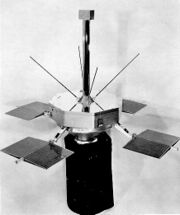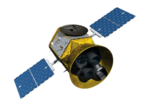Astronomy:Explorer 15
 Explorer 15 (EPE-C) | |||||||||||||
| Mission type | Space physics | ||||||||||||
|---|---|---|---|---|---|---|---|---|---|---|---|---|---|
| Operator | NASA | ||||||||||||
| Harvard designation | 1962 βλ1 | ||||||||||||
| COSPAR ID | 1962-059A[1] | ||||||||||||
| SATCAT no. | 445 | ||||||||||||
| Spacecraft properties | |||||||||||||
| Bus | EPE Bus | ||||||||||||
| Launch mass | 44.4 kg (98 lb) | ||||||||||||
| Start of mission | |||||||||||||
| Launch date | 27 October 1962, 23:17 UTC[2] | ||||||||||||
| Rocket | Delta A[3] | ||||||||||||
| Launch site | Cape Canaveral Air Force Station LC-17B | ||||||||||||
| End of mission | |||||||||||||
| Decay date | 19 December 1978 | ||||||||||||
| Orbital parameters | |||||||||||||
| Reference system | Geocentric | ||||||||||||
| Regime | Highly Elliptical | ||||||||||||
| Eccentricity | 0.56183[1] | ||||||||||||
| Perigee altitude | 300 km (190 mi)[1] | ||||||||||||
| Apogee altitude | 17,438 km (10,835 mi)[1] | ||||||||||||
| Inclination | 18°[1] | ||||||||||||
| Period | 311.4 minutes[1] | ||||||||||||
| Epoch | 27 October 1962[1] | ||||||||||||
| Instruments | |||||||||||||
| |||||||||||||
Explorers | |||||||||||||
Explorer 15, also called EPE-C, was an United States satellite launched as part of the Explorers program. Explorer 15 was launched on October 27, at Cape Canaveral Air Force Station , Florida, United States , with a Delta rocket.
Mission
Explorer 15 was a spin-stabilized, solar cell-powered spacecraft instrumented to study the artificial radiation belt produced by the Starfish high-altitude nuclear burst of July 1962. The backup payload for Explorer 14 was modified and used for Explorer 15. The instrumentation included three sets of particle detectors to study both electrons and protons, and a two-axis fluxgate magnetometer to determine magnetic aspect. A 16-channel PFM/PM time-division multiplexed telemeter was used. The time required to sample the 16 channels (one frame period) was 0.323 s. Half of the channels were used to convey eight-level digital information, and the others were used for analog information. During ground processing of the telemetered data, the analog information was digitized with an accuracy of 1/100th of full scale.
One analog channel was subcommutated in a pattern 16 frames long and was used to telemeter spacecraft temperatures, power system voltages, electric currents, etc. A digital solar aspect sensor measured the spin period and phase, digitized to 0.041 s, and the angle between the spin axis and the sun direction to about 3° intervals. During launch the spacecraft failed to despin. The spin rate ranged from 72.9 to 73.2 rpm during the life of the spacecraft. The spin axis pointed at right ascension 80.97° and declination 20.9°.[1]
References
- ↑ 1.0 1.1 1.2 1.3 1.4 1.5 1.6 1.7 "Explorer 15". NSSDC Master Catalog. NASA Goddard Space Flight Center. https://nssdc.gsfc.nasa.gov/nmc/spacecraft/display.action?id=1962-059A.
 This article incorporates text from this source, which is in the public domain.
This article incorporates text from this source, which is in the public domain.
- ↑ "Jonathan's Space Page". http://www.planet4589.org/space/log/launchlog.txt.
- ↑ "EPE". Encyclopedia Astronautica. Mark Wade. http://www.astronautix.com/e/epe.html.


